

The empirical status of cognitive-behavioral therapy: A review of meta-analyses. This review summarizes the current meta-analysis literature on treatment outcomes of CBT for a wide range of psychiatric disorders.

A search of the literature resulted in a total of 16 methodologically rigorous meta-analyses. Our review focuses on effect sizes that contrast outcomes for CBT with outcomes for various control groups for each disorder, which provides an overview of the effectiveness of cognitive therapy as quantified by meta-analysis. Large effect sizes were found for CBT for unipolar depression, generalized anxiety disorder, panic disorder with or without agoraphobia, social phobia, posttraumatic stress disorder, and childhood depressive and anxiety disorders. Effect sizes for CBT of marital distress, anger, childhood somatic disorders, and chronic pain were in the moderate range. CBT was somewhat superior to antidepressants in the treatment of adult depression.
Copyright © 2005 Elsevier Ltd. GetSharedSiteSession?rc=1&redirect= To view the full text, please login as a subscribed user or purchase a subscription.
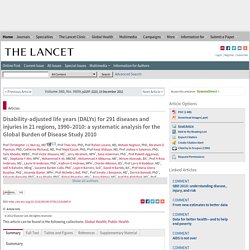
Click here to view the full text on ScienceDirect. Figure 1 Years of life lost due to premature mortality and years lived with disability composition of total disability-adjusted life years by age and sex, 2010 Composition in male individuals (A) and female individuals (B). DALY=disability-adjusted life years. Figure 4. Sciencedirect. Perspective 1 Department of Cell, Developmental, and Cancer Biology and Knight Cancer Institute, Oregon Health and Science University, Portland, OR 97034 Available online 6 April 2015 Choose an option to locate/access this article: Check if you have access through your login credentials or your institution Check access.

GetSharedSiteSession?rc=1&redirect= The hallmarks of cancer comprise six biological capabilities acquired during the multistep development of human tumors.
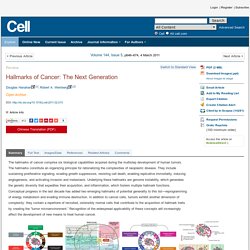
The hallmarks constitute an organizing principle for rationalizing the complexities of neoplastic disease. They include sustaining proliferative signaling, evading growth suppressors, resisting cell death, enabling replicative immortality, inducing angiogenesis, and activating invasion and metastasis. Underlying these hallmarks are genome instability, which generates the genetic diversity that expedites their acquisition, and inflammation, which fosters multiple hallmark functions. Conceptual progress in the last decade has added two emerging hallmarks of potential generality to this list—reprogramming of energy metabolism and evading immune destruction. Pharmacological management of fluid overload. Standard treatment practice for the hypotensive patient with poor tissue perfusion is rapid volume resuscitation; in some scenarios, such as septic shock, this is performed with targeted goal-directed endpoints within 6 h of presentation.1–3 Such critically ill patients often develop, or are at risk for, significant positive fluid accumulation as an adverse effect.4 Multiple observational studies demonstrate a strong, independent association with increasing fluid accumulation and poor outcome in children5–11 and adults,12–17 although it is important to note that no study has directly demonstrated that fluid overload (FO) causes poor outcome.
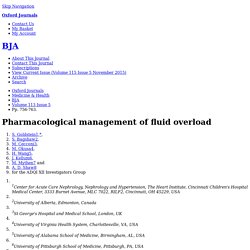
Initially, this association was observed in critically ill children who received continuous renal replacement therapy (CRRT). Data from adult studies yield similar results. These data argue for a fluid management strategy aimed to prevent fluid accumulation. Methods Findings Indications to avoid active pharmacological fluid management Fig 1 Table 1 Fig 2. Vascular content, tone, integrity, and haemodynamics for guiding fluid therapy: a conceptual approach. The characterization of shock is fundamentally a cellular definition wherein the oxygen requirements of parenchymal cells to sustain respiration needed to produce ATP are exceeded by that being delivered by the circulation.1 Hypovolaemia is one type of shock where this can occur and is described by the condition where there is inadequate tissue perfusion as a consequence of reduced vascular content (vC).
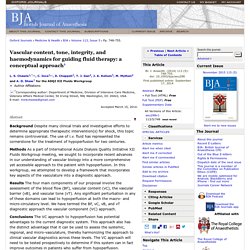
It can occur because of the systemic loss of volume such as in haemorrhagic shock but also to a defect of a normal or even elevated cardiac output resulting in absolute or regional hypovolaemia. In such conditions, fluid administration is the optimal therapy to increase the vC in the expectation of promoting tissue perfusion and improve oxygen transport to the tissues. Despite many clinical trials and investigative efforts to determine appropriate therapeutic intervention(s) for shock, this topic remains controversial and there remain broad areas where no consensus exists. Methods. Four phases of intravenous fluid therapy: a conceptual model. + Author Affiliations Abstract I.V. fluid therapy plays a fundamental role in the management of hospitalized patients.
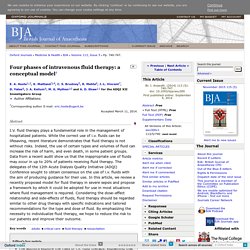
While the correct use of i.v. fluids can be lifesaving, recent literature demonstrates that fluid therapy is not without risks. Concussion is confusing us all. Headache management: pharmacological approaches. Coagulation assessment with the new generation of oral anticoagulants. Special tests for assessing meniscal tears within the knee: a systematic review and meta-analysis. + Author Affiliations Correspondence to Benjamin E Smith, Department of Physiotherapy Outpatients, London Road Community Hospital, Derby Hospitals NHS Foundation Trust, London Road, Derby DE1 2QY, UK; benjamin.smith3@nhs.net Introduction ‘Special tests’ have been a historical part of the physical examination during the clinical assessment of musculoskeletal knee pain,9 and a number of these special tests are thought to diagnose torn menisci.
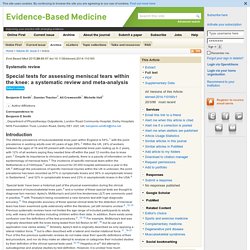
Apley's, McMurray's and joint line tenderness (JLT) are commonly used in practice,10 with Thessaly's being considered a new dynamic test with high diagnostic accuracy.11 The diagnostic accuracy of these special clinical tests for the detection of meniscal tears has been examined quite extensively within the literature, yet still remains unclear.9 ,12–15 Previous systematic reviews have not limited the age range of included participants to adults only, with many of the studies including children within their data.
Method Search strategy Study selection.